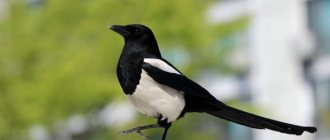Bird species
All birds are divided into three types:
- sedentary - such birds live in one territory permanently, without changing their place of residence, usually they are representatives of the tropics and subtropics; in the northern regions and central part of Russia these are those urban birds that are accustomed to living close to humans,
- nomadic - they constantly move somewhere, and regardless of the weather and time of year, they fly from one place to another, but within their habitat, they do this in order to find more food,
- migratory - these, when the seasons change, regularly make long flights from north to south and back, these include the majority of those living in the northern and temperate zones.
You won’t see migratory birds in winter; they fly away and return to us when it gets warmer. But the sedentary and nomadic ones - wintering ones, they will be with us throughout the cold season.
Owl
The eagle owl is the largest bird among the owls, its height is 0.6–0.8 m, its wingspan is up to 1.9 m. It is distributed throughout Eurasia, except the far north. Hunts by planning. It is a wintering sedentary species.
The plumage is motley, brown tones, loose, absorbs the sounds of flight. There are feathers sticking out on the head, like “ears”. The paws are completely covered with feathers, the claws are large. Amber eyes stand out on the facial disc. During courtship, partners call each other loudly, forming permanent pairs.
Thanks to the special structure of the spine, the eagle owl's head can even turn backwards.
Hunts in the evening all night. It feeds on rodents, hares, birds, frogs, and fish.
Nests are located on the ground, in the roots of trees, among brushwood. The female incubates, the male feeds her and the chicks. The chicks are covered with down and blind. At 2 months they begin to fly, at 3–4 months they leave their parents.
Rice. 3. Eagle owl.
Who flies away from their homeland and why?
Migratory birds include swallows, wild geese, starlings, rooks and many others. When cold weather sets in, they fly away to where it is warm, returning back to their native places, which they left in the fall.
Why do birds leave their native lands?
Among the main reasons are cold and lack of food. Winter time is not as scary for them as a lack of food. Birds are warm-blooded creatures, their average body temperature is about 41 degrees. In addition, the down under the plumage helps prevent hypothermia. Therefore, they are able to maintain their vital functions in harsh winters, which cannot be said about their activity without a sufficient amount of food.
What do birds eat in summer?
Mainly insects. All their living prey - bugs and worms - either die with the cold or go to sleep, hiding deep in the ground. Therefore, those who do not have grain or plant roots on their menu are forced to fly to warm countries where there are many insects.
Among the inhabitants of forests and populated areas, half of the birds are migratory. Almost everything that lives in swamps and reservoirs flies to where it is warmer. So, storks and herons get ready for a long journey when ponds and rivers freeze. It is difficult to get frogs and fish out from under the ice, and small rodents have long since hidden in their burrows.
Did you know?! The rook is the last to fly away. But he is among the first to return from wintering to his native land, somewhere between March 4 and March 23. That’s why there is an expression: “Rooks have opened spring.” After them, starlings and larks fly home.
Thematic lesson for children “wintering and migratory birds”
The thematic activity is very simple if wintering and migratory birds depicted in photographs or drawings are used - pictures with names for children are simply necessary, otherwise they will not be able to form stable visual images and remember new information for them. Visual perception is usually well developed already in preschool, so this material can be studied with preschoolers.
A lesson about wintering birds traditionally begins with a simple question: Why does it become difficult for birds to live in cold regions during the winter? This is how we voice the main problem of the lesson and look for a solution.
Usually, children are given answer options indicating uncomfortable living conditions in winter: cold, fear of freezing. A refutation of this theory is the fact that birds have well-developed plumage, which means they are not afraid of the cold. (Think of a goose or swan duvet stuffed with duvets—warm winter clothing that people enjoy wearing in freezing weather).
We gently help the child think about what other needs each member of the animal world has, including birds. Let's move on to the basic need of a living organism - nutrients and remember what is usually included in the diet of birds - insects, berries and other fruits.
How do birds know when and where to fly?
When autumn approaches, migratory birds gather in flocks, arranging training, so that they can then fly for several hours, covering enormous distances, without losing their course. How do they do it?
Migratory birds can determine the road without a compass. Scientists have proven that they absolutely accurately determine their geographical location, flying long distances every year, perfectly oriented in time and space.
- Ornithologists believe that the sun at noon above the horizon can serve as a guide for them.
- Some experts are confident that for their path, birds use magnetic lines surrounding the Earth, which are located in the direction from the north to the south pole.
- There is also a version that birds know how to use the stars, determining their location by constellations.
Be that as it may, many experiments have already been carried out when birds were taken long distances, and they returned to their native nests over and over again.
Many people prepare for the flight in advance, when it is still warm. The instinct laid down by nature, like a bell, gives them the order to fly south to survive the winter and return back to hatch chicks. Scientists call this the migratory impulse, which serves as the start for the flight. Also, the trigger that calls for flight is the changed length of the day. By the beginning of autumn, daylight hours become shorter.
When flying, some species reach speeds of up to 100 kilometers per hour, rising to a height of 3 thousand meters. Bird travel is associated with difficulties and dangers. The smaller the bird, the shorter its path in one flight. Birds are capable of not stopping for 80 hours or more! They interrupt their flight to gain strength and feed, so long-distance flights can last up to three months.
Did you know?! The migratory bird cuckoo flies to Africa. But unlike other birds, no one has yet observed these birds in flocks. They strangely disappear in the fall, with the older ones earlier than the younger generations. And they usually fly at night and, probably, alone.
Settled, wintering birds: list, photos with names
To help the birds that remain over the winter find food, feeders are hung. And it is quite possible that they will be of interest to the following visitors:
- Sparrow . Noisy sparrows that fly in flocks may well become the first visitors to the feeder.
flock of sparrows
- Tit. Tits are in many ways not inferior to sparrows; they quickly rush to feed in feeders. But compared to sparrows, tits are endowed with a more gentle disposition. Interestingly, in the summer the tit eats almost as much food as it weighs. You can often see mixed flocks of both sparrows and tits at feeders.
Tit with a piece of bread
Sparrows and tit
- Gaichka . A close relative of the tit. However, the chickadee's breast is not yellow, but light brown. The chickadee also differs from other tits in that it makes a hollow in a tree to make a nest in it.
The chickadee is a special type of tit
- Crow. Ravens are often confused with rooks. It is known that in the western part of Russia crows are very rare. Therefore, if you live in the European part of Russia and see a black bird emitting a piercing croak, then most likely it is a rook.
Black Crow
- Pigeon. The distribution and lifestyle of pigeons was largely influenced by people who simply brought them with them to different parts of the Earth. Now pigeons are found on all continents except Antarctica. Pigeons easily exchange rocks, which are their natural habitat, for man-made structures.
The nodding gait of pigeons is due to the fact that this makes it easier for them to examine the object of interest to them.
- Woodpecker. In the warm season, woodpeckers feed mainly on insects, which they get from under the bark of trees, and in the cold winter, they can also feed on plant foods: seeds and nuts.
Woodpeckers love to eat seeds from pine and spruce cones.
- Magpie. The magpie is considered a bird of high intelligence; it is capable of expressing a lot of emotions, including sadness, and can recognize its reflection in the mirror. It is interesting that not only its fellow birds react to the alarming cry of a magpie, but also other birds, as well as wild animals, in particular bears and wolves.
Magpie - wintering bird
- Owl . Owls come in different varieties, large and small, and there are more than 200 species in total. These birds are endowed with acute vision and excellent hearing, which allows them to lead a nocturnal lifestyle. It is interesting that the tufts on the owl's head are not ears, the real ears of owls are hidden in the feathers, and one of them is directed upward, and the other downwards, in order to better hear what is happening above the head and on the ground.
Owl is a night bird
- Owl. This bird is also considered an owl and is a close relative of other owls.
Owl
- Tawny owl. A rare owl that lives mainly in mountainous areas in northern latitudes. The name of the bird, according to different versions, means “inedible” or “insatiable.”
Tawny Owl
- Jackdaw. Externally, jackdaws are similar to rooks and crows; moreover, there are mixed flocks in which all three species of birds can be seen. However, the jackdaw is smaller in size than the crow. And if you are lucky enough to observe a jackdaw up close, you can easily recognize it by the gray color of some of its feathers.
Jackdaws really like shiny objects
- Nuthatch. This little bird climbs tree trunks very deftly. In summer, nuthatches hide seeds and nuts in the bark, and in winter they feed on these supplies.
Nuthatch on a birch tree
- Crossbill. Like the nuthatch, this bird is excellent at climbing trees and can hang upside down on branches. Crossbill's favorite food is seeds from spruce and pine cones. This bird is remarkable in that it can hatch chicks even in winter, but only if there is enough food.
Crossbill on spruce branches
- Bullfinch. Only males have bright red plumage on the chest; females look much more modest. Bullfinches are more often seen in winter, because due to lack of food, they are drawn to people. In summer, bullfinches prefer wooded areas and behave inconspicuously, so they are not easy to see.
Pair of bullfinches
- Waxwing . A bird with beautiful plumage and a singing voice. In summer it feeds mainly on insects and likes to settle in coniferous forests. In winter, the waxwing moves to more southern regions of the country and is often found in cities. In the cold season, rowan and other fruits become the main food for birds.
Waxwing on a rowan branch in winter
- Jay. A large bird, which, however, can fly to feast on a feeder hung by people. In the summer it is rarely seen in the city, but closer to winter the bird begins to reach out to human habitation.
Jay in winter
- Kinglet. One of the smallest birds, the weight of an adult male is only 5-7 grams. Kinglets are relatives of sparrows.
Kinglet - forest dweller
- Pheasant . A large bird that is a favorite trophy for many hunters. Pheasants can fly, but most often move on foot.
Pheasant
- Hazel grouse . It is also an object of hunting, despite the fact that this bird is quite small. The weight of an adult hazel grouse rarely reaches 500 g. Interestingly, the largest population of these birds lives in Russia.
The hazel grouse is a bird that is related to the black grouse
- Black grouse. Another bird that is related to hunting. Black grouse are found at the edge of the forest and in the forest-steppe.
Grouse
- Sokol . It is considered one of the smartest birds on the planet and one of the best hunters. The falcon is capable of working in tandem with a person, but it is very difficult to tame it.
Falcon in flight
- Hawk . Like the falcon, it is a bird of prey. A hawk's vision is 8 times sharper than a human's. And rushing after prey, the hawk can reach speeds of up to 240 km/h.
Hawk
To which countries do migratory birds fly?
Many of them love Africa. Birds even fly there from the Arctic and Siberia. Most waterfowl, such as ducks and swans, winter in western Europe. From Russia, blackbirds and starlings move to the French or Spanish south, but cranes are lovers of the banks of the river called the Nile. Among the long-distance marathon runners are windbreakers from Eastern Siberia. They chose the shores of New Zealand for wintering.
However, among migratory birds there are patriots who move within our country closer to the warm domestic south. Among them are the hooded crow and the black rook.
Did you know?! Some species of ducks called “mallards” cross more than one country on their way to their wintering grounds. They fly over Belarus, Ukraine, through Germany and Holland, through Denmark and Great Britain, as well as across northern Italy and, ultimately, stop in western Europe.
Bird theme - the world around us, grade 2
migratory birds list for children
what kind of bird is the cuckoo
bluethroat bird
sedentary and nomadic birds
eagle owl bird photo
Which bird from the order Galliformes is migratory?
Quail flies to warmer climes
We are accustomed to consider Galliformes to be sedentary birds that are incapable of long flights. But even among them there is a species that decides to make such a long journey. The small and fragile quail, in order not to spend the winter in the cold, goes with all the migratory birds to warmer climes. As a rule, it winters in South-West Asia or Africa.
Birds around the world 3rd grade
what migratory birds are in Russia: central Russia
what birds winter in Russia: central Russia
Why do migratory birds fly to warmer regions where they spend the winter, and why do they come back?
Migratory birds fly to warmer climes so as not to starve in winter
Most people mistakenly think that birds fly to warmer climates because cold weather is approaching. Yes, it also indirectly affects their behavior, but still most of them can easily tolerate the cold.
Birds are leaving their homes due to the fact that the amount of food is sharply reduced in autumn and winter. Therefore, in order not to die of hunger, they have to migrate and look for places where they can eat the same as before. Birds can winter in India, Africa, Greece, Spain, Italy or the British Isles.
As for why they come back, ornithologists cannot give an exact answer to this question. Some believe that they cannot find a normal nesting place there, while others claim that small parasites, which multiply very quickly in a hot climate, do not allow them to stay there.






